This article needs additional citations for verification .(June 2014) |

Cape Gloucester (also known as Tuluvu) is a headland on the northern side of the far west of the island of New Britain, Papua New Guinea.
This article needs additional citations for verification .(June 2014) |

Cape Gloucester (also known as Tuluvu) is a headland on the northern side of the far west of the island of New Britain, Papua New Guinea.
During World War II, the Japanese captured New Britain, and had driven most of Cape Gloucester's native population out to construct two airfields. [1] During the New Britain Campaign, American forces had decided to capture Cape Gloucester for its two airfields, to assist planned attacks on the garrison on Rabaul, an important area in New Britain. It became the site of the Battle of Cape Gloucester, part of Operation Cartwheel, in 1943. After long fighting through rain and Japanese, the United States 1st Marine Division had it declared secured. After the war, the headland was given back to the natives.

New Britain is the largest island in the Bismarck Archipelago, part of the Islands Region of Papua New Guinea. It is separated from New Guinea by a northwest corner of the Solomon Sea and from New Ireland by St. George's Channel. The main towns of New Britain are Rabaul/Kokopo and Kimbe. The island is roughly the size of Taiwan.

The Battle of the Bismarck Sea took place in the South West Pacific Area (SWPA) during World War II when aircraft of the U.S. Fifth Air Force and the Royal Australian Air Force (RAAF) attacked a Japanese convoy carrying troops to Lae, New Guinea. Most of the Japanese task force was destroyed, and Japanese troop losses were heavy.
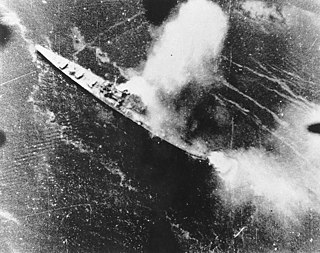
The bombing of Rabaul in November 1943 was an air attack conducted by the Allies of World War II upon a cruiser force at the major Japanese base of Rabaul. In response to the Allied invasion of Bougainville, the Japanese had brought a strong cruiser force down to Rabaul from Truk, their major naval base in the Caroline Islands about 800 miles north of Rabaul in preparation for a night engagement against the Allied supply and support shipping. Allied carrier- and land-based planes attacked the Japanese ships, airfields, and port facilities on the island of New Britain to protect the Allied amphibious invasion of Bougainville. As a result of the Rabaul raids, the Japanese naval forces could no longer threaten the landings. The success of the raid began to change the strongly held belief that carrier-based air forces could not challenge land-based air forces.

The Battle of Rabaul, also known by the Japanese as Operation R, an instigating action of the New Guinea campaign, was fought on the island of New Britain in the Australian Territory of New Guinea, from 23 January into February 1942. It was a strategically significant defeat of Allied forces by Japan in the Pacific campaign of World War II, with the Japanese invasion force quickly overwhelming the small Australian garrison, the majority of which was either killed or captured. Hostilities on the neighbouring island of New Ireland are usually considered to be part of the same battle. Rabaul was significant because of its proximity to the Japanese territory of the Caroline Islands, site of a major Imperial Japanese Navy base on Truk.

The New Georgia campaign was a series of land and naval battles of the Pacific Theater of World War II between Allied forces and the Empire of Japan. It was part of Operation Cartwheel, the Allied strategy in the South Pacific to isolate the Japanese base around Rabaul. The campaign took place in the New Georgia Islands in the central Solomon Islands and followed the Allied capture of the Russell Islands. The main fighting took place on New Georgia itself, although significant actions also took place around the island chain throughout the campaign.
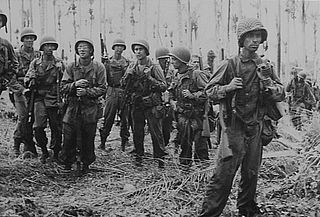
The New Britain campaign was a World War II campaign fought between Allied and Imperial Japanese forces. The campaign was initiated by the Allies in late 1943 as part of a major offensive which aimed to neutralise the important Japanese base at Rabaul, the capital of New Britain, and was conducted in two phases between December 1943 and the end of the war in August 1945.
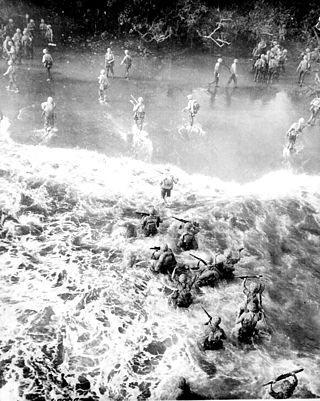
The Battle of Cape Gloucester was fought in the Pacific theater of World War II between Japanese and Allied forces on the island of New Britain, Territory of New Guinea, between 26 December 1943 and 16 January 1944. Codenamed Operation Backhander, the US landing formed part of the wider Operation Cartwheel, the main Allied strategy in the South West Pacific Area and Pacific Ocean Areas during 1943–1944. It was the second landing the US 1st Marine Division had conducted during the war thus far, after Guadalcanal. The objective of the operation was to capture the two Japanese airfields near Cape Gloucester that were defended by elements of the Japanese 17th Division.

Ariake was the fifth of six Hatsuharu-class destroyers, built for the Imperial Japanese Navy under the Circle One Program. Three were laid down in JFY 1931 and the next three in JFY 1933.

The Battle of Arawe was fought between Allied and Japanese forces during the New Britain campaign of World War II. The battle formed part of the Allied Operation Cartwheel and was a diversion before a larger landing at Cape Gloucester in late December 1943. The Japanese military was expecting an Allied offensive in western New Britain and was reinforcing the region at the time of the Allied landing in the Arawe area on 15 December 1943. The Allies secured Arawe after about a month of intermittent fighting with the outnumbered Japanese force.

The Battle of Labuan was an engagement fought between Allied and Imperial Japanese forces on the island of Labuan off Borneo during June 1945. It formed part of the Australian invasion of North Borneo, and was initiated by the Allied forces as part of a plan to capture the Brunei Bay area and develop it into a base to support future offensives.

Pavuvu is the largest of the Russell Islands in Central Province, Solomon Islands. It is located northwest of Guadalcanal. The area is 129.19 square kilometres (49.88 sq mi). The largest village is Nukufero on the north coast.

Operation Dexterity was a military operation, part of Operation Cartwheel in the South West Pacific Area (SWPA) for the Allies in the Pacific theater of World War II. The operation was directed by the Supreme Allied Commander in the SWPA, General Douglas MacArthur. Dexterity included amphibious landings at Arawe on 15 December 1943, and Cape Gloucester on 26 December 1943 in the northwest of New Britain, the capture of the Imperial Japanese held Tuluvu aerodrome on the 30 December 1943 and the amphibious landing at Saidor on 2 January 1944. The final battle was the landing at Talasea in March. The operation ended on 9 March 1944.
Cape Gloucester Airport is an airport in West New Britain Province, Papua New Guinea.. The airport is a single runway general aviation facility; at the present time there is no scheduled commercial service to the airport.

Technical Air Intelligence Units (TAIU) were joint Allied military intelligence units formed during World War II to recover Japanese aircraft to obtain data regarding their technical and tactical capabilities.
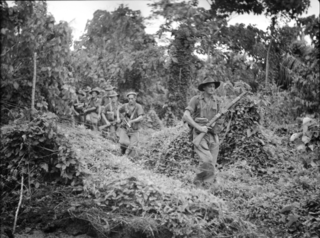
The Battle of Wide Bay–Open Bay was a battle during the New Britain campaign of the Second World War. Following the arrival of the Australians on New Britain in late 1944, replacing the US garrison on the island, they began a limited offensive against the Japanese forces on the island. Pushing east from the positions previously captured by the US troops earlier in the year, after landing at Jacquinot Bay on the southern coast in November, the Australians began advancing across the island towards the Gazelle Peninsula, where they sought to isolate the numerically superior Japanese garrison. This advance was effected along two axes: Cape Hoskins to Open Bay on the northern coast, and Jacquinot Bay to Wide Bay on the southern. Once the Australians had secured a line across the island between Wide Bay and Open Bay in March and April 1945, the fighting on New Britain died down as the Australians sought to contain the larger Japanese garrison while limiting their own casualties. This situation lasted until the end of the war in August 1945.
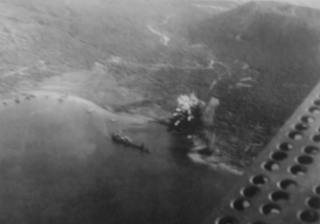
The neutralisation of Rabaul was an Allied campaign to render useless the Imperial Japanese base at Rabaul in eastern New Britain, Papua New Guinea. Japanese forces landed on Rabaul on 23 January 1942, capturing it by February 1942, after which the harbor and town were transformed into a major Japanese naval and air installation. The Japanese heavily relied on it, using it as a launching point for Japanese reinforcements to New Guinea and Guadalcanal. Throughout the Solomon Islands campaign, neutralizing Rabaul became the primary objective of the Allied effort in the Solomons.

The Battle of Talasea was fought in the Pacific theater of World War II between Japanese and Allied forces. Dubbed "Operation Appease" by the Allies, the battle was part of the wider Operations Dexterity and Cartwheel, and took place on the island of New Britain, Territory of New Guinea, in March 1944 as primarily US forces, with limited Australian support, carried out an amphibious landing to capture the Talasea area of the Willaumez Peninsula, as part of follow-up operations as the Japanese began withdrawing east towards Rabaul following heavy fighting around Cape Gloucester earlier in the year. The assault force consisted of a regimental combat team formed around the 5th Marines, which landed on the western coast of the Willaumez Peninsula, on the western side of a narrow isthmus near the Volupai Plantation. Following the initial landing, the Marines advanced east towards the emergency landing strip at Talasea on the opposite coast. Their advance south was stymied by a small group of Japanese defenders who prevented the US troops from advancing quickly enough to cut off the withdrawal of the Japanese force falling back from Cape Gloucester.

Cape Gloucester is a coastal rural locality in the Whitsunday Region, Queensland, Australia. In the 2021 census, Cape Gloucester had a population of 85 people.

Edgecumbe Bay is a bay in the Whitsunday Region, Queensland, Australia.

US Naval Base New Guinea was number of United States Navy bases on the island of New Guinea during World War II. Australia entered World War II on 3 September 1939, being a self-governing nation within the British Empire. The United States formally entered the war on 7 December 1941, following the attack on Pearl Harbor by the Empire of Japan. Following the attack on Pearl Harbor, Japan quickly took over much of the South Pacific Ocean. The United States lost key naval bases in the South Pacific, including Naval Base Manila and Naval Base Subic Bay, both lost in the 1941–42 invasion of the Philippines. Also lost were Naval Base Guam and Wake Atoll. As such, the United States Armed Forces needed new bases in the South West Pacific for staging attacks on Japan's southern empire. The United States built bases first in Australia, then in New Guinea.
5°27′S148°25′E / 5.45°S 148.42°E